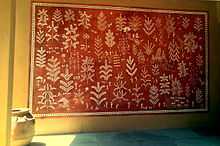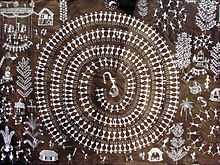Warli painting
Warli painting is a tribal art mostly done by Adivasi from North Sahyadri Range in India (Dahanu, Talasari, Jawhar, Palghar, Mokhada, and Vikramgadh).

In the book The Painted World of the Warlis Yashodhara Dalmia claimed that the Warlis carry on a tradition stretching back to 2500 or 3000 BCE. Their mural paintings are similar to those done between 500 and 10,000 BCE in the Rock Shelters of Bhimbetka, in Madhya Pradesh.
Their extremely rudimentary wall paintings use a very basic graphic vocabulary: a circle, a triangle and a square.Their paintings were monosyllbic. The circle and triangle come from their observation of nature, the circle representing the sun and the moon, the triangle derived from mountains and pointed trees. Only the square seems to obey a different logic and seems to be a human invention, indicating a sacred enclosure or a piece of land. So the central motive in each ritual painting is the square, known as the "chauk" or "chaukat", mostly of two types: Devchauk and Lagnachauk. Inside a Devchauk, we find Palaghata, the mother goddess, symbolizing fertility.[1] Significantly, male gods are unusual among the Warli and are frequently related to spirits which have taken human shape. The central motif in these ritual paintings is surrounded by scenes portraying hunting, fishing and farming, festivals and dances, trees and animals. Human and animal bodies are represented by two triangles joined at the tip; the upper triangle depicts the trunk and the lower triangle the pelvis. Their precarious equilibrium symbolizes the balance of the universe, and of the couple, and has the practical and amusing advantage of animating the bodies.

The pared down pictorial language is matched by a rudimentary technique. The ritual paintings are usually done inside the huts. The walls are made of a mixture of branches, earth and cow dung, making a red ochre background for the wall paintings. The Warli use only white for their paintings. Their white pigment is a mixture of rice paste and water with gum as a binding. They use a bamboo stick chewed at the end to make it as supple as a paintbrush. The wall paintings are done only for special occasions such as weddings or harvests. The lack of regular artistic activity explains the very crude style of their paintings, which were the preserve of the womenfolk until the late 1970s. But in the 1970s this ritual art took a radical turn, when Jivya Soma Mashe and his son Balu Mashe started to paint, not for any special ritual, but because of his artistic pursuits. Warli painting also featured in Coca-Cola's 'Come home on Diwali' ad campaign in 2010 was a tribute to the spirit of India’s youth and a recognition of the distinct lifestyle of the Warli tribe of Western India.[2]
See also
References
- ↑ Tribhuwan, Robin D.; Finkenauer, Maike (2003). Threads Together: A Comparative Study of Tribal and Pre-historic Rock Paintings. Delhi: Discovery Publishing House. pp. 13–5. ISBN 81-7141-644-6.
- ↑ http://www.business-standard.com/article/press-releases/coca-cola-india-celebrates-ancient-warli-folk-art-form-launches-110101200123_1.html
External links
Category:Indian painting